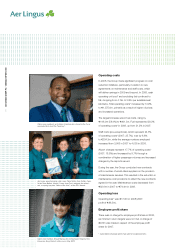Aer Lingus 2008 Annual Report Download - page 19
Download and view the complete annual report
Please find page 19 of the 2008 Aer Lingus annual report below. You can navigate through the pages in the report by either clicking on the pages listed below, or by using the keyword search tool below to find specific information within the annual report.
Emissions to waters/sewers: Aer Lingus is subject
to regulation and licensing in relation to surface water
and sewer emissions from operations such as de-icing,
fuel/oil spillages and catering sewer emissions. Aer
Lingus has pollution prevention policies and procedures
in place across its network and works closely with airport
authorities to ensure full compliance and to avoid penalties
and fines.
Infrastructure efficiency: Aer Lingus is committed to
reducing costs in the airport environment. The Airline
has introduced technology, which reduces demand for
terminal space, such as self-service check-in and bag-
tag kiosks and the “web check-in” facility. All of these
technologies allow more efficient use of terminal space.
Energy monitoring: Energy consumption is regularly
monitored and benchmarked against industry standards
and best practice. “Green” electricity is used at stations
where available.
Health, safety and security
Safety organisation: Aer Lingus maintains the highest
standards in air safety through the commitment of
management and staff to place air safety as their
foremost priority. Air safety is a core value of Aer Lingus
and is managed pro-actively in accordance with Safety
Management System (SMS) described in the Group’s Air
Safety Manual.
Aer Lingus’ SMS is directed by the Safety Manager.
This role reports directly to the Chief Executive, ensuring
continued accountability and awareness of these issues
and their importance within the Group. The Safety
Manager has overall responsibility for the internal offices
of Air Safety, Health and Safety and Quality Assurance
(See Figure 3).
The Aer Lingus SMS comprises a systematic, corporate
approach to the management of safety that puts in place
the necessary organisational structure, accountability,
policies and procedures. In 2008, Aer Lingus reinforced
its commitment to air safety through the investment of
significant further resources in its Air Safety Office. Aer
Lingus is required to operate an SMS that complies
with international standards, and to this end, under the
leadership of the Safety Manager, a team of subject
matter experts and specialists have been recruited into
the Group’s Air Safety Office to manage and promote air
safety within Aer Lingus. An operational aircraft engineer
has been appointed as Technical Safety Officer.
The Group places great emphasis on proactive
and predictive systems to manage safety. The SMS
involves the ongoing routine collection and analysis
of safety data during the ordinary course of business,
which enables proactive management. This includes
a Flight Data Monitoring Programme, a Confidential
Air Safety Reporting System and a specific Hazard
Identification and Risk Analysis (HIRA) programme.
During 2008 Aer Lingus introduced enhancements to
its air safety reporting systems as part of an ongoing
strategy to maintain industry-leading processes in safety
management.
In 2008 Aer Lingus received confirmation of its
successful compliance with its first IATA Operational
Safety Audit (IOSA). Aer Lingus is now registered as an
IOSA Operator under the IATA Operational Safety Audit
Programme. The IOSA programme is an internationally
recognised and accepted evaluation system designed
to assess the operational management and control
systems of an airline.
The principles of air safety management are integral to all
Aer Lingus’ training programmes. Courses are designed
around the prevention of accidents and cover all aspects
of flight operations, including the handling of dangerous
goods, aviation security and emergency response
planning. Staff training in all operational departments is
mandatory. Training records and processes are regularly
subject to external review and audit. Aer Lingus is
subject to regular safety reviews, in particular, from
the Irish Aviation Authority (IAA) and other airlines.
Aircraft maintenance, repair and overhaul are critical to
the safety and comfort of Aer Lingus’ passengers, the
efficient use of its aircraft and the optimisation of its fleet
utilisation. The Aer Lingus maintenance system is subject
to repeated audit inspections by the IAA.
There is a programme of continual review and audit
to ensure ongoing compliance with the Safety, Health
and Welfare at Work Act 2005, as updated by General
Applications Regulations 2007 and with all relevant
safety regulations.
Information and advice for customers on air travel
and health is available on the Group’s website,
www.aerlingus.com, in the in-flight magazine, Cara,
and through on-board announcements and videos.
17
AER LINGUS GROUP PLC - ANNUAL REPORT 2008
























